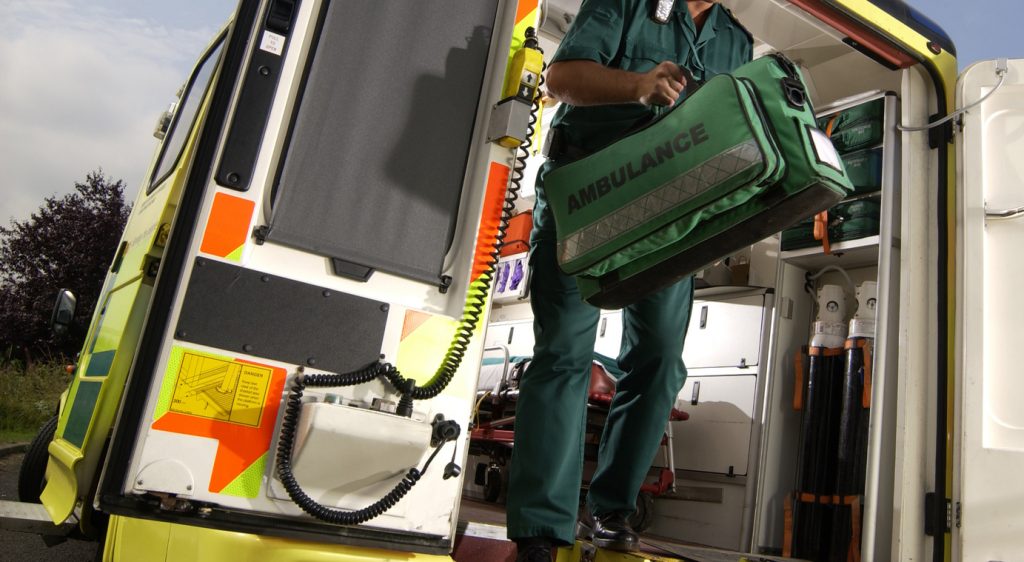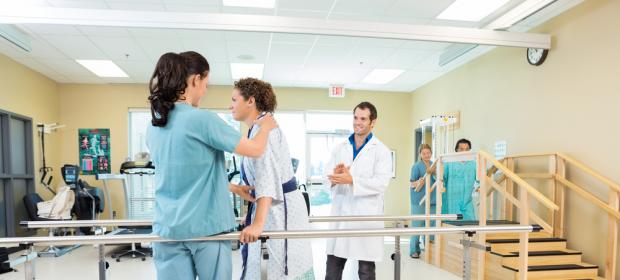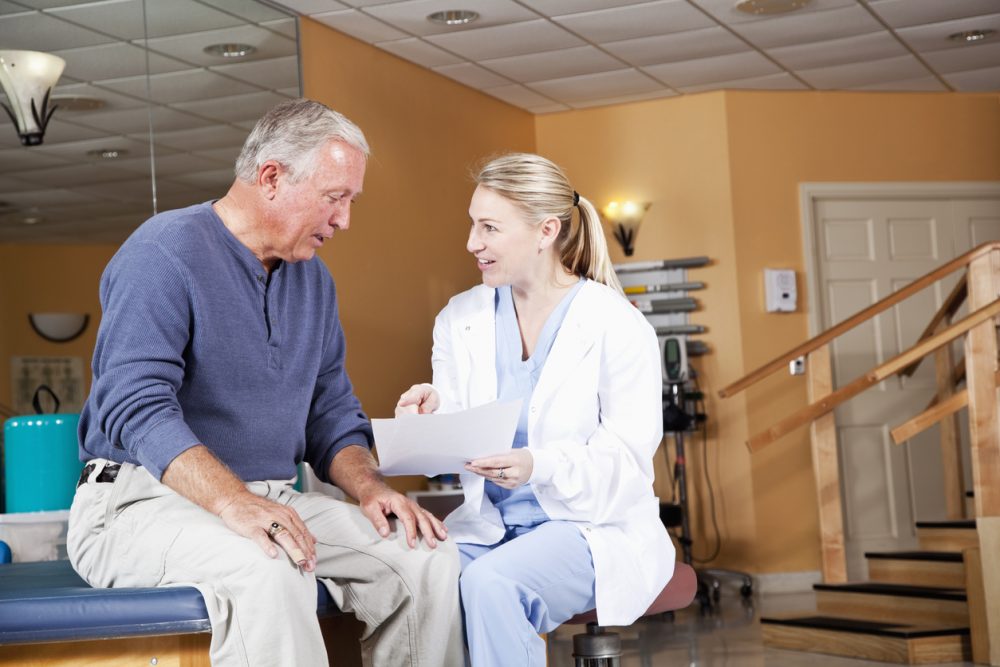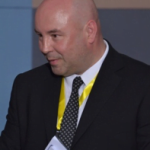In this blog for stroke survivors, their families and clinical staff, Mark Smith, Consultant Physiotherapist in Stroke Rehabilitation, looks at Cochrane evidenceCochrane Reviews are systematic reviews. In systematic reviews we search for and summarize studies that answer a specific research question (e.g. is paracetamol effective and safe for treating back pain?). The studies are identified, assessed, and summarized by using a systematic and predefined approach. They inform recommendations for healthcare and research. on physical rehabilitation approaches for the recovery of function and mobility following stroke and explores the importance of the findings with respect to service delivery in an ever changing landscape of health and social care.
Stroke is often termed a “recovering neurological condition”, but how much recovery can we expect in response to what sorts of interventionA treatment, procedure or programme of health care that has the potential to change the course of events of a healthcare condition. Examples include a drug, surgery, exercise or counselling. and in what doses? Strokes happen as a result of a disturbance of the blood supply to the brain, mostly in older people and mostly due to the blocking of arteries supplying oxygenated blood to the brain. But less commonly, strokes can affect younger people (and children) and may also be the result of a burst blood vessel causing a haematoma (collection of blood) within the brain mass.
Acting FAST
The stroke “pathway” extends from the initial hyper-acute episode, usually the first minutes and hours post onset of symptoms in the community setting, emphasising that “time is brain” through the “FAST” (Face, Arm, Speech, Time to call 999) campaign supported by the main UK stroke charities, Stroke Association and Chest, Heart & Stroke Scotland. The aim is to deliver patients with a suspected stroke to appropriately specialist hospital/stroke unit care as soon as possible in order to receive life saving and disability reducing hyper-acute interventions such as thrombolysis (using clot-busting drugs) and more recently thrombectomy (breaking and removing the clot with tools) in patients who meet the necessary criteria.

This hyper-acute stage of the pathway is highly evidence-based, medicalised and thoroughly audited across the UK by the two main stroke audits – Sentinel Stroke National Audit Programme (SNNAP) in England and Wales, and the Scottish Stroke Care Audit (SSCA) in Scotland, with a view to time critical delivery to all eligible patients. However, the subsequent audit around rehabilitation interventions can be less thorough despite a growing body of evidence to support physical interventions.
Ongoing physical rehabilitation: what should we do?
Most patients with stroke will need some kind of ongoing physical rehabilitation to assist them in achieving best outcomesOutcomes are measures of health (for example quality of life, pain, blood sugar levels) that can be used to assess the effectiveness and safety of a treatment or other intervention (for example a drug, surgery, or exercise). In research, the outcomes considered most important are ‘primary outcomes’ and those considered less important are ‘secondary outcomes’. possible (with respect to the severity of the stroke but also with respect to the resource available) and we are increasingly becoming aware that there are some critical elements in achieving that. But can we, and do we, deliver what patients should receive in our publicly funded UK health and social care system and is the evidence sufficiently persuasive to argue strongly for this? How do we ensure that a health condition such as stroke which spans a pathway from the community through hyper-acute medical hospital care, possibly downstream in-patient rehabilitation and back to the community via health and social care is fit for purpose? And how do we remove the diagnostic stroke “badge” and simply allow an individual to function again in society with the support they need to manage their long term condition?
Perhaps there is a persuasive argument for delivering evidence-based stroke rehabilitation with appropriate levels of quality and intensity as it is considered a human right in many societies?

The evidence for physical rehabilitation after stroke
Evidence for physical interventions relating to walking and physical rehabilitation after stroke is becoming increasingly available in the form of high quality systematic reviewsIn systematic reviews we search for and summarize studies that answer a specific research question (e.g. is paracetamol effective and safe for treating back pain?). The studies are identified, assessed, and summarized by using a systematic and predefined approach. They inform recommendations for healthcare and research. that can inform clinical guidelines as well as high level government strategy with respect to stroke. We tend to find it mostly relating to physical therapy and exercise/fitness interventions.
Updating Cochrane evidence: a novel approach
Pollock et al (2014a) revisited an older Cochrane Review (Pollock et al 2009). Previous versions of the review had focussed on physiotherapy interventions for the lower limb and walking after stroke but they decided to use a novel approach in the reappraisal of the literature and update of the evidence. The review was subsequently re-titled Physical Rehabilitation Approaches for the Recovery of Function, Balance and Walking following Stroke. The academic elements of reviewing papers followed the usual Cochrane protocolThe plan or set of steps to be followed in a study. A protocol for a systematic review should describe the rationale for the review, the objectives, and the methods that will be used to locate, select, and critically appraise studies, and to collect and analyse data from the included studies. The protocols for Cochrane Reviews are available in the Cochrane Library..
Seeking “real world” views on the evidence
In order to gauge the relevance of the evidence for clinical practice, but also critically for stroke survivors and carers, in parallel with revisiting the evidence through systematic review,co Pollock and colleagues also convened a multi key stakeholder short life working group comprised of stroke survivors, carers and clinical staff. This group was charged with sense-checking and “validating” the evidence as being clinically relevant as it emerged, using formal group consensus methods based on nominal group techniques. This involved a system of voting which focussed the group in reaching consensus. The academic researchers involved in the systematic review attended the working group meetings and presented the various options in directing the review, but did not vote themselves so as to minimise biasAny factor, recognised or not, that distorts the findings of a study. For example, reporting bias is a type of bias that occurs when researchers, or others (e.g. drug companies) choose not report or publish the results of a study, or do not provide full information about a study.. This arm of the project culminated in a presentation at the 2014 Cochrane UK and Ireland Symposium, held in Manchester, in which key stakeholders in the review led a workshop on user-involvement in writing Cochrane ReviewsCochrane Reviews are systematic reviews. In systematic reviews we search for and summarize studies that answer a specific research question (e.g. is paracetamol effective and safe for treating back pain?). The studies are identified, assessed, and summarized by using a systematic and predefined approach. They inform recommendations for healthcare and research.. The dual aims of this work were to determine if physical treatmentSomething done with the aim of improving health or relieving suffering. For example, medicines, surgery, psychological and physical therapies, diet and exercise changes. approaches are effective in the recovery of function and mobility in patients with stroke and to see whether any one physical treatment approach is more effective than any other approach.
The presentation of the updated evidence as a result
Ninety six studies, involving 10,401 stroke were included in the review (Pollock et al 2014a). Results of 27 studies (3243 stroke survivors) could be combined comparing physical rehabilitation with no treatment at all. Twenty five of these studies were carried out in China and were unusual in that they compared an active treatment/intervention group to a control group with no clinical intervention. Additional physical rehabilitation versus usual care was described in 12 of these studies demonstrating improved motor function (887 stroke survivors), standing balance (five studies, 246 stroke survivors) and walking speed (14 studies, 1126 stroke survivors). There was also limited evidence of dose intensity for the first time, with treatment durations given between 30 and 60 minutes per day apparently carrying the most significant benefits, but future research needs to verify this.
Key messages:
- Physiotherapy, using a mix of components from different approaches, is effective for the recovery of function and mobility after stroke. Treatment sessions of 30-60 minutes, 5-7 days a week may provide a significant beneficial effect.
- No one approach to physical treatment is any more (or less) effective in promoting recovery of function and mobility after stroke.
Physiotherapists should use their expert clinical reasoning to select individualised, patient-centred, evidence-based physical treatment, with consideration of all available treatment components, and should not limit their practice to a single “named” approach.

Fitness training after stroke
This work is supported by another recently updated Cochrane Review around Fitness Training for Stroke Survivors (Saunders et al 2016) which included 58 trialsClinical trials are research studies involving people who use healthcare services. They often compare a new or different treatment with the best treatment currently available. This is to test whether the new or different treatment is safe, effective and any better than what is currently used. No matter how promising a new treatment may appear during tests in a laboratory, it must go through clinical trials before its benefits and risks can really be known. involving 2797 participants with stroke. These studies were grouped according to the type of fitness training intervention – cardiorespiratory (28 trials, 1408 participants) resistance (13 trials, 432 participants) and mixed training (17 trials, 4342 participants).
Key messages:
- Cardiovascular fitness training, particularly involving walking, can improve exercise ability and walking after stroke.
- Mixed training improves walking ability and improves balance.
- Unable to draw reliable conclusions regarding effects on quality of life, mood or cognitive function.
- No evidence of injury or other health problems and exercise appears to be a safe intervention.
Circuit Class Therapy
English et al (2017) included 17 trials involving 1297 stroke survivors (most of whom could walk 10 metres) in another recent Cochrane Rcoeview to examine the effectivenessThe ability of an intervention (for example a drug, surgery, or exercise) to produce a desired effect, such as reduce symptoms. and safetyRefers to serious adverse effects, such as those that threaten life, require or prolong hospitalization, result in permanent disability, or cause birth defects. of Circuit Class Therapy (CCT) on mobility in adults with stroke. Ten studies (835 participants) measured walking capacity, demonstrating that CCT was superior to the comparison intervention, eight measured gait speed again finding that CCT was of significant benefit. Their conclusion was that there was moderate evidence to suggest that CCT is effective in improving mobility for people after stroke. These effects may be greater later after the stroke and stroke survivors may be able to walk further, faster, with more independence and confidence in their balance, but further high quality research is required.
Other relevant reviews
There have also been Cochrane Reviews providing low to moderate quality evidence of the rehabilitation benefits of electro mechanically or robotic assisted gait training devices (Mehrholz et al 2017a), treadmill training for stroke patients who could already walk (Mehrholz et al 2017b) and repetitive task training (French et al 2016). A Cochrane overviewCochrane Overviews of reviews (Overviews) are intended to summarize multiple Cochrane Reviews addressing the effects of two or more potential interventions (for example a drug, surgery, or exercise) for a single condition or health problem. (a review of systematic reviews) presenting moderate quality evidence for upper limb rehabilitation after stroke, suggested beneficial effects of constraint-induced movement therapy (CIMT), mental practice, mirror therapy, interventions for sensory impairment, virtual reality and a relatively high dose of repetitive task practice (Pollock et a. 2014b). Again, information was insufficient to reveal the relative effectiveness of different interventions.
So what…
Well, the research evidence, albeit largely of moderate quality, points to the efficacyThe extent to which an intervention (for example a drug, surgery, or exercise), produces a beneficial result under ideal conditions. of a broad range of interventions in the physical rehabilitation of people with stroke, with little detail about which specific interventions are of most value in which settings, and indeed the best delivery mechanisms to make them most easily and effectively implemented. More research is needed to generate higher quality evidence and implementation guidance. Recommendations in stroke guidelines (RCP 2016) and stroke strategies (Scottish Government 2014) have been made on the basis of these findings, particularly with respect to adequate dose. However, given that studies are disparate, have been derived from around the world and as a result conducted within a great variety of different healthcare (and social care/leisure) settings, it is challenging for clinicians to know exactly how to implement the reported findings.
The work of Pollock et al (2014) in engaging multi key stakeholders in making more “real” the findings of their systematic review made an effort to think about how we might implement the evidence, particularly in relation to the views of stroke survivors, carers and therapists. Perhaps we need to be less defensive of historical professional and service silo boundaries and use this evidence in the best interests of the stroke survivors we aim to serve, though imaginative use of commissioning mechanisms, third sector organisations, the leisure industry, healthcare staff resources and the capacity we have to deliver stroke rehabilitation interventions?
The World Health Organisation (WHO) has recently argued that the benefits of rehabilitation are realised beyond the health sector and that delivered appropriately can reduce care costs and enable participation in education and gainful employment (WHO 2017). With respect to the stroke pathway, if we are serious about saving lives at the “front door”, let’s also make them worth living at the “back door” and beyond.
Join in the conversation on Twitter with @CochraneUK #LifeAfterStroke or leave a comment on the blog.
Mark Smith is a Trustee of the Stroke AssociationA relationship between two characteristics, such that as one changes, the other changes in a predictable way. For example, statistics demonstrate that there is an association between smoking and lung cancer. In a positive association, one quantity increases as the other one increases (as with smoking and lung cancer). In a negative association, an increase in one quantity corresponds to a decrease in the other. Association does not necessarily mean that one thing causes the other..
Page updated 02 November 2020



Wonderfully helpful Mark! I Thankyou for your passion, time and generosity putting this together and most importantly for sharing 🙏
How about specific stroke rehabilitation medical devices? A family member is keen to source something that is tried and tested.
Stroke physical therapists are able to stimulate affected muscles and nerves to maintain circulation and prevent stiffness, then guide patients through the stages of stroke recovery as they relearn basic muscle movements. Today, many physical therapists specialize in stroke and other types of neurological trauma….(myGenericPharmacy)
post-stroke rehabilitation is very important because it helps maximize the functional independence of patients who suffer from various disabilities related to stroke. rehabilitation process must be considered so that it can be fully cured. This article is very useful, thanks for sharing!
http://news.unair.ac.id/2018/07/19/mahasiswa-unair-menc Created-inovasi-alat-rehabilitasi-paska-stroke/
I found the article beneficial. Being a physiotherapist myself, in Nigeria, the challenge commonly faced is that of early referral and compliance by patients in terms of ward or home programs. I found the literate patients to be more compliant and thus recover faster and better.
Interesting article, Mark, and a comprehensive look at available evidence. As you know, I need no convincing as to the efficacy of exercise after stroke. The psychological and emotional benefits of exercise, though possibly more difficult to measure, should not be underestimated either, both in general and specifically for stroke survivors